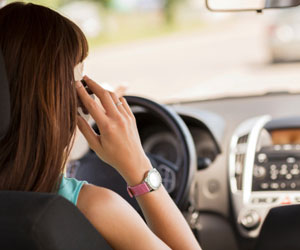Investigating the Siren Song of Mobile Devices in the Car
The vast majority of U.S. states ban motorists from texting while driving, and at least a dozen bar even voice conversations over a handheld device. Similar prohibitions are being enacted around the world.
But so far they haven’t made a substantial dent in distracted driving.
 At any given moment during the day in the United States, approximately 660,000 drivers are using a handheld communications device instead of concentrating on the road, according to the National Highway Traffic Safety Administration.
At any given moment during the day in the United States, approximately 660,000 drivers are using a handheld communications device instead of concentrating on the road, according to the National Highway Traffic Safety Administration.
So why do so many of us ignore the dangers of texting or chatting on the phone when we’re behind the wheel?
The answer may lie in the fact that, as numerous studies have shown, motorists spend more time responding to incoming calls and texts than actually initiating them. Science suggests that we may feel socially obligated to respond quickly when our cell phone rings, vibrates, or dings—even when we’re operating a car.
A new study in Australia provides additional evidence of this phenomenon.
Psychological scientists Louise P. Waddell and Karl K.K. Wiener of Charles Sturt University recruited volunteers to participate in an online survey. The 181 participants were asked to rate their behaviors, attitudes, and intentions regarding the use of mobile devices while driving. (Only 8% of them reported using hands-free devices on a regular basis.)
The questions were designed to capture individuals’ past use of mobile communications devices while driving, their attitudes and expectations about doing so in the future, and their perceptions about their control of their driving ability and behavior. The respondents also were asked to rate how much they believed their friends and family members endorsed and engaged in texting/calling while driving.
Twenty-nine percent of the respondents reported having initiating a mobile voice call while driving, while 44% reported answering a call. Meanwhile, 28% reported sending a text message while behind the wheel, compared with 57% who reported reading texts.
Drivers overall held rather negative attitudes toward using mobile devices while driving. But they held more receptive views about responding to calls and texts in their vehicles. They also largely felt that responding to incoming calls and texts is a common behavior.
Participants who regarded texting and talk on the phone while driving as a widespread practice, and who showed the most confidence in their own driving behavior, showed higher intentions to both initiate and respond to texts and calls.
In a report on their study in the journal Transportation Research Part F, Waddell and Wiener acknowledge that their results may be skewed by the fact that 79% of the participants were women. But they add that the mobile device usage could be higher among drivers than the findings indicate, since many respondents may have been reluctant to admit to behavior that is illegal in so many jurisdictions.
The researchers suggest that traffic safety campaigns not only emphasize the sheer dangers of communicating on mobile devices while driving, but also raise drivers’ awareness about the subtle social pressures that may trigger them to respond. Such campaigns should also attempt to dispel the notion that it’s normal to text or talk on the phone while driving.





APS regularly opens certain online articles for discussion on our website. Effective February 2021, you must be a logged-in APS member to post comments. By posting a comment, you agree to our Community Guidelines and the display of your profile information, including your name and affiliation. Any opinions, findings, conclusions, or recommendations present in article comments are those of the writers and do not necessarily reflect the views of APS or the article’s author. For more information, please see our Community Guidelines.
Please login with your APS account to comment.